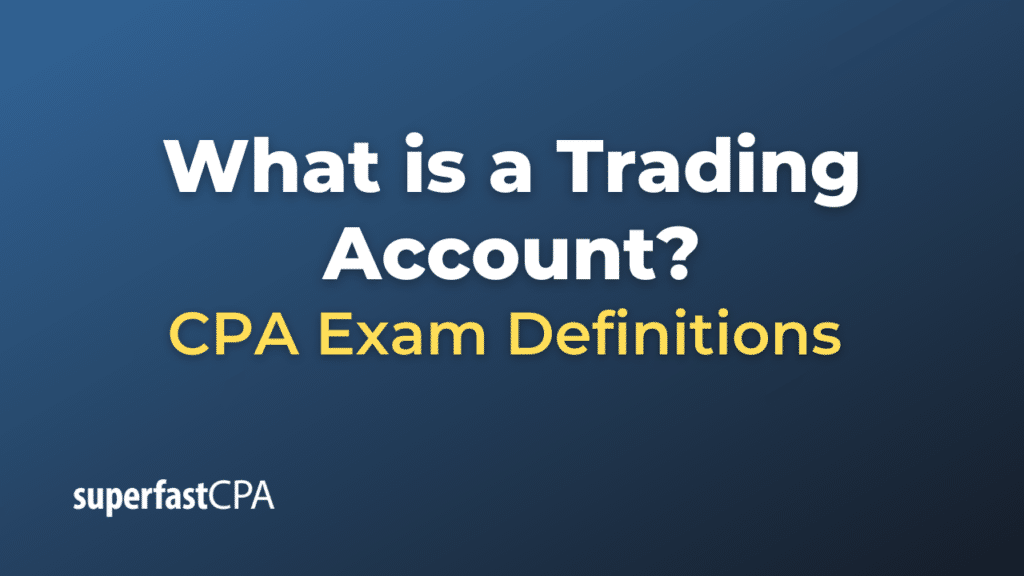Trading Account
A trading account is an account held by a broker or financial institution that allows individuals to buy and sell securities such as stocks, bonds, commodities, and other financial instruments. Trading accounts are used by both individual retail traders and professional traders to execute trades in the financial markets.
Here’s a breakdown of what a trading account is and how it functions:
- Opening a Trading Account: Before you can start trading, you first need to open a trading account with a brokerage firm. This process typically involves providing personal identification information, filling out an application, and potentially answering questions about your financial situation and trading experience.
- Deposits and Withdrawals : Once your account is set up, you can deposit money into your trading account, typically through wire transfers, checks, or other electronic methods. This money will serve as collateral for your trades and will be used to buy and sell securities. You can also withdraw money from your trading account, subject to the terms and conditions of your brokerage.
- Trading Platforms: Most brokerage firms provide their clients with online trading platforms that allow them to place trades, manage their portfolios, conduct research, and analyze market data. These platforms vary in terms of their features, user-friendliness, and other aspects.
- Leverage and Margin: Many trading accounts offer leverage, which allows traders to control larger positions with a smaller amount of money. This is achieved through the use of margin, which essentially is a loan from the broker to the trader. While leverage can amplify profits, it also amplifies losses, making it a double-edged sword that traders should use with caution.
- Types of Orders: With a trading account, you can place various types of orders, such as market orders (buy or sell at the current market price), limit orders (buy or sell at a specified price or better), and stop orders (buy or sell once a certain price is reached).
- Costs: Trading accounts usually come with associated costs. This can include commissions for trades, account maintenance fees, margin interest, and other costs. It’s essential to be aware of these costs and factor them into your trading strategy.
- Statements and Reporting : Brokerage firms provide regular statements for trading accounts, which detail all transactions, current holdings, margin usage, and more. This helps traders keep track of their performance and ensures transparency in their operations.
In conclusion, a trading account is an essential tool for anyone looking to actively participate in the financial markets. It’s crucial, however, to understand the mechanics, risks, and costs associated with trading before diving in.
Example of a Trading Account
Let’s use a simple example to illustrate how a trading account works:
John’s First Trading Account
- Opening the Account:
- John decides he wants to start trading stocks. After researching different brokerage firms, he chooses “XYZ Brokers” and opens a trading account online.
- During the application process, he provides his personal details, undergoes a KYC (Know Your Customer) check, and answers questions about his financial health and trading experience.
- Depositing Funds:
- Once his account is approved, John deposits $5,000 into his trading account via an electronic bank transfer.
- Using the Trading Platform:
- John logs into the online trading platform provided by XYZ Brokers. He familiarizes himself with the interface, the various tools available for research, and the procedure to place trades.
- Making the First Trade:
- After doing some research, John decides he wants to buy shares of a company called “TechStar.
- The current market price of TechStar is $50 per share.
- John decides to buy 50 shares, so he places a market order. This means he’s agreeing to buy the shares at whatever the current market price is.
- The total cost for this purchase is $2,500 (50 shares x $50/share).
- Monitoring and Selling:
- Over the next few months, TechStar performs exceptionally well, and its stock price rises to $60 per share.
- Seeing a good profit, John decides to sell his shares. He places a market order to sell his 50 shares at the current market price of $60.
- John receives $3,000 from the sale (50 shares x $60/share).
- Calculating Profit and Costs:
- John’s initial purchase was $2,500. He sold the shares for $3,000, so his gross profit is $500.
- However, XYZ Brokers charges a $10 commission for every trade. John made two trades (one buy and one sell), so he paid $20 in commissions.
- Therefore, John’s net profit from this trade is $480 ($500 gross profit – $20 commissions).
- Reviewing Statements:
- At the end of the month, John receives a statement from XYZ Brokers detailing his transactions, his current cash balance, any fees charged, and other account activities.
This example gives a basic overview of how a trading account functions. In the real world, trading can be more complex due to factors like taxes, dividends, varying commissions, and other costs, as well as the use of advanced order types and strategies.













